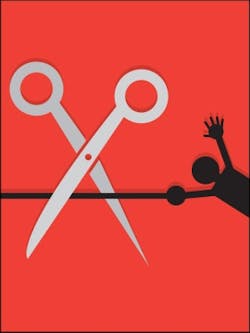When it comes to what he refers to as “bottom-feeder customers,” longtime industry consultant and president of the Institute for Automotive Business Excellence Cecil Bullard doesn’t mince words.
“They will eat you alive,” he says. “They will eat your time, they will eat your profits and they will make it difficult for you to see the world clearly and take care of that client who is ready and willing to come in and pay you as much as you need to be paid.”
If you’re spending that time with the bottom-feeder customers, Bullard says, you won’t have the time, the attention or the proper attitude to deal with the people who are loyal, value-based customers willing to pay.
“My thought process is that shops should be chasing away the bottom 5 to 10 percent of their customers every year,” he says.
The way to do that is simple, Bullard says, and requires a combination of raising your prices, creating more value in your business and marketing your shop in a way that naturally eliminates bottom-feeder customers.
Bullard and Ron Inchausti—owner of the $5.5-million-per-year Coast Motor Werk in Southern California, who has grown his business to four locations by getting rid of his bottom-tier customers—explain the steps any shop can take to fire its worst customers.
STEP ONE: DEFINE YOUR 'CARDBOARD CUTOUT' CUSTOMER
Before you can chase away your bad customers, you need to identify your best customers. Bullard calls this exercise creating your “cardboard cutout” customer.
“What that is, is the client that I want to work with in my business that is going to come in here and pay me and allow me to be successful,” he says. “Every business owner should sit down annually and say, these are the kind of people that are going to make my business successful and this is who I’m going to market to.”
When Inchausti took over an existing shop in 2005, it wasn’t the BMW-specialized, four-location business that Coast Motor Werk is today. Defining the cardboard cutout customer, he says, not only changed his philosophy on marketing, it has also been instrumental in the growth of his business.
“When you’re a shop owner, it sounds sort of alien to market to one individual person. It makes you think you’re going to alienate everyone else,” says Inchausti. “The reality is, you work smarter and not harder. You realize that the person you’re marketing to is truly your clientele. That’s the person who is the easiest and most identifiable when it comes to what you do.”
Inchausti identified his ideal client by spending an afternoon going through every listing in his database and classifying each as an A, B or C customer.
“We started with, are all BMW owners good enough? Well, no, we don’t want the tuners, we don’t want the backyard mechanics, we don’t want the racers. We want the people who want to come in and get the service and repairs done,” he says. “Is Mr. Smith an A customer? He’s kind of tricky and problematic and doesn’t make his appointment. You realize pretty quickly that the A customers are the ones that fit your cardboard cutout.”
If you don’t currently track your customers, Bullard says to start doing this now and evaluate as you go along.
Through the exercise, Inchausti started to notice a trend and realized that his cardboard cutout was a wife who makes a lot of the buying decisions, drives a BMW 5-series, works part-time and has a couple of children.
STEP TWO: RAISE YOUR PRICES
Most shops don’t charge enough, says Bullard, and it only takes raising your prices 10 percent for the bottom-tier customers to get the hint that your shop isn’t the place for them.
“I can mathematically show any shop in the world that I can chase away your bottom 10 percent of customers by raising your prices 10 percent,” he says. “You will come out ahead by six miles.”
Take, for example, a shop that does $1 million in sales per year. If the bottom 10 percent of customers leave, Bullard says, that’s going to cut the shop’s sales to $900,000 (assuming the bottom 10 percent have equal average repair orders as the other 90 percent, which isn’t always the case). However, if prices are raised 10 percent at that point, the shop will do $990,000 in business with 10 percent less customers.
“That $90,000 is going to drop straight to the bottom line in [gross] profit,” he says. “Even though we may need $10,000 of that to pay fixed expenses, I’m still going to make $80,000 more on 10 percent less customers.”
In addition, Bullard says not to be scared of raising your labor rate. In fact, he says it’s the simplest way to make more money. And, he guarantees there will be no discernable loss of clients.
“If you ask any shop owner, they would tell that there’s no measurable loss of clients,” he says. “Maybe they lost one or two clients who were the cheap ones, but really, they couldn’t tell you which clients they lost. In every single instance, those businesses were more financially prosperous.”
STEP THREE: MARKET TO YOUR CARDBOARD CUTOUT
A quick distinction between marketing and advertising: Marketing is a big-picture item, Bullard notes, while advertising is the specific ads you run to get the message across.
“Marketing is pricing, the way the shop looks, what we wear, how we talk to people, what we charge, how we pay our people,” he says. “Once we know the kind of clients that make us successful, our marketing is designed to attract that person.”
This is when you need to be especially cognizant of the way your shop looks and how your staff interacts with and treats the customer. Raise your deliverable to provide complimentary loaners cars; a three-year, 36,000-mile warranty; and complimentary car washes. The bottom line, he says, is that you need to show why your shop is worth the price, beyond just repairing the car properly.
For Inchausti, he knew that he needed to make his shop an environment where women felt comfortable. He renovated his building with that in mind and included numerous touches, such as making sure the bathrooms are clean and stocked with hand lotion and diffusers. He added magazines in the lounge that are varied and current. The repair orders are written in a specific way now, and the service writers are trained to speak to the customers.
The effect, Inchausti says, was that the non-cardboard cutout customers naturally started leaving on their own.
“When we remodeled our customer lounge, we made it really nice. I could see the look on certain customers’ faces who weren’t our A customer. They would walk in and the first thing on their mind was, ‘This is going to be expensive,’ because they would take that impression of the customer lounge and apply that to the cost of the repair,” he says. “But when our cardboard cutout would walk in, they would say, ‘It smells so nice in here.’ Having the things that really meant something to the customer were the kind of thing that really reaffirmed the cardboard cutout staying and the not-so-cardboard cutout leaving.”
STEP FOUR: ADVERTISE WITHOUT GIVING AWAY YOUR SERVICES
Bullard frequently cites an industry statistic that 18 percent of your shop’s clients are going to leave every year. One percent may pass away, another percent will move, but of that 18 percent, he says more than half will leave your shop because of indifference.
“In other words, the customer wasn’t treated as if they were important,” he says. “Now that you know that, I need a marketing plan that’s going to give me those new customers. We’ve got our cardboard cutout, we’ve determined who we want. We’ve gone out and we’ve done just about everything we can to figure out where those people are and what will attract them.”
The biggest mistake for advertising to new customers? Offering discounts. It’s a one-way ticket to attracting the cheap, disloyal customers you’re trying to chase away, Bullard says.
“If you’re running a discount model, you’re going to spend a lot of money advertising to bring new customers in every day because the customers that are coming in are only coming in for the discount. You’re going to continually spend that money and they’re not loyal,” he says. “You may find a loyal customer, but that’s going to be the exception, not the rule.”
For Inchausti, advertising to new clients means online sites like Angie’s List or accumulating Google reviews, as well as advertising in magazines that the cardboard cutout might read.
Bullard recommends reevaluating your marketing plan quarterly, looking at the numbers to determine who came from what sources, what they spent and the ROI. If something isn’t working, consider whether it’s the ad or the location of the ad, and adjust accordingly.
STEP FIVE: TELL BAD CUSTOMERS TO LEAVE
Chances are, steps one through four will be enough to chase away the bottom-tier customers naturally. But if not, Bullard says you might need to be more explicit.
“The third time they come in and they won’t let me fix something and they’ve already had some other guy fix it, I need to tell them, ‘Hey wait a minute,’” he says. “I need to teach my people to be verbally able to tell them, ‘This is not how it works here. And frankly, if you’re going to come in for the discount oil change, then you need to allow me to fix your car or you need to go to whoever you’ve allowed to fix your car and let them do your oil changes, too.’”
This should be done in a polite way, of course, and Bullard says that you should include a recommendation for a shop in town that is less expensive. Be prepared to respond to a potential negative online review, he says, but don’t get defensive.
“I need to constantly be thinking of my best customers and not my worst customers,” he says. “When I determine that you’re a cheap person and you want everything done cheap, I’m going to send you to that guy. Why would I bring you into my business, which isn’t the cheapest but is going to be the best, and argue over price when I could send you down to Joe’s Garage down the street who’s really cheap and willing to give his stuff away?”



